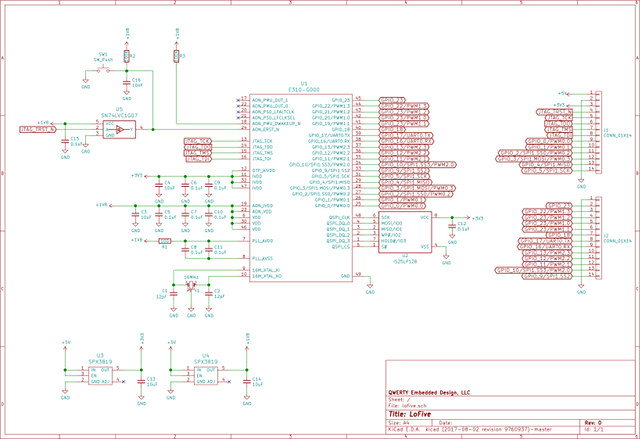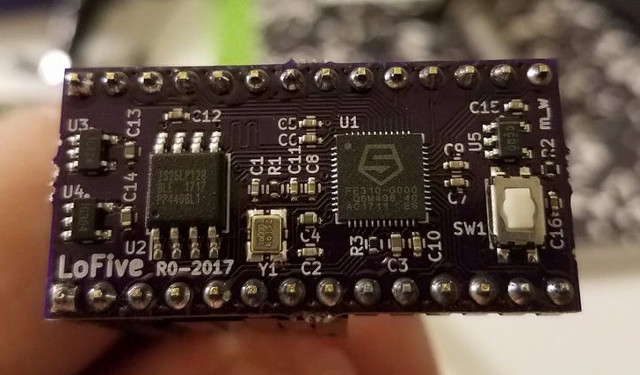Do you remember HiFive1? It’s an Arduino compatible board based on the SiFive FE310 open source RISC-V SoC. Michael Welling has now started working on LoFive board using the same processor, but in a much smaller & breadboard friendly form factor.
LoFive board specifications:
- MCU – SiFive Freedom E310 (FE310) 32-bit RV32IMAC processor @ up to 320+ MHz (1.61 DMIPS/MHz)
- Storage – 128-Mbit SPI flash (ISSI IS25LP128)
- Expansion – 2x 14-pin headers with JTAG, GPIO, PWM, SPI, UART, 5V, 3.3V and GND
- Misc – 1x reset button, 16 MHz crystal
- Power Supply – 5V via pin 1 on header; Operating Voltage: 3.3 V and 1.8 V
- Dimensions – 38 x 18 mm (estimated)
The board will be programmable with Arduino IDE + Cinco just like HiFive1 board.

The board is also open source hardware, so beside the aforelinked info on Hackster,io, you’ll also find the KiCAD schematics, PCB layout, and 3D renders, released under CERN Open Hardware License v1.2, on Github.

Jean-Luc started CNX Software in 2010 as a part-time endeavor, before quitting his job as a software engineering manager, and starting to write daily news, and reviews full time later in 2011.
Support CNX Software! Donate via cryptocurrencies, become a Patron on Patreon, or purchase goods on Amazon or Aliexpress. We also use affiliate links in articles to earn commissions if you make a purchase after clicking on those links.






There is also a Hackaday project page with some more informations: https://hackaday.io/project/26909-lofive
Unfortunately and according to Michael Welling, FE310 MCUs are available as engineering samples only for now.
@DurandA
But how do they manage to sell the HiFive1? They can’t be going off engineering samples, can they?
I looked at the product page for the FE310. Its not very competitive in this day and age: high cost/low features.
The ESP32 is far more compelling as the “Swiss Army Knife” of products in this category. It even has floating point hardware that the FE310 lacks.
My advice for “RISC V” would be to focus on “massive scale” complexes. This is where the lack of license cost will offer them an advantage. They should be making 1024 core chips with SIMD (which is not yet available) for use in the emerging AI / Neural Network / Skynet industry.
From a user perspective, what’re the benefits of RISC-V over other ISAs.
@gizmoduck
From an architectural point of view, I saw nothing noteworthy or novel about RISC-V. Its a run-of-the-mill RISC architecture (load/store).
Its *potential* impact is the same a Linux. Whether it translates to benefits to the end user is highly dependent on the user just as it is with Linux. Right now, its appeal is mostly academic. Whether it reaches the “critical mass” to be disruptive or not remains to be seen.
My hope is that it that encourages others to grab a FPGA and experiment, learn, and expand upon it. Its an incredible time to be alive for anyone interested in tech. The world is there for the taking.
For FAQ. Frequently Asked Questions about RISC-V
https://riscv.org/faq/
@crashoverride
Thank you for the response. It sounds like RISC-V mostly benefits chip makers and academics and not so much end-users who buy complete boards or even people choosing an SoC to integrate into custom boards. Unless it’s somehow easier to bring up custom boards with RISC-V than say ARM/x86 or other benefits I’m not familiar with.
The board can be purchased for $25 + shipping on GroupGets https://groupgets.com/campaigns/353-lofive-risc-v
The sale will only go ahead if 100 boards are pre-ordered.
@blu
A five-pack of FE310 chips is now available on https://www.crowdsupply.com/sifive/hifive1 for $25.
The board can be purchased on Tindie for $29.99 https://www.tindie.com/products/mwelling/lofive/
@cnxsoft
This Tindie store was retired but you can get them on the second round of the campaign:
https://groupgets.com/campaigns/376-lofive-risc-v-round-2